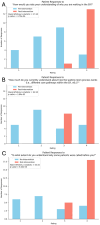From Frustration to Understanding: The Effectiveness of an Emergency Department Waiting Room Video in Enhancing Patient Satisfaction
- PMID: 41020161
- PMCID: PMC12475326
- DOI: 10.1177/23743735251383265
From Frustration to Understanding: The Effectiveness of an Emergency Department Waiting Room Video in Enhancing Patient Satisfaction
Abstract
This pilot study evaluated the impact of a brief, animated educational video on patient understanding and satisfaction in a large urban academic emergency department (ED). A convenience sample of 23 patients viewed a 1-min 50-s video explaining triage, wait times, and ED workflows, then completed pre- and postintervention surveys. Statistically significant improvements were observed across all domains of understanding. Mean 4-point Likert scores rose from 2.48 to 3.93 (p < .0001) for understanding why patients wait, from 2.25 to 3.78 for why others may be seen first, and from 2.81 to 4.00 for overall ED processes. This intervention offers a low-cost, scalable, and staff-efficient solution to enhance communication, set expectations, and improve the overall patient experience in ED waiting rooms. These findings highlight the potential of patient-centered media to support transparency and trust in emergency care.
Keywords: communication; emergency medicine; health literacy; patient education; patient satisfaction; wait times.
© The Author(s) 2025.
Conflict of interest statement
The authors declared no potential conflicts of interest with respect to the research, authorship, and/or publication of this article.
Figures

References
-
- de Steenwinkel M, Haagsma JA, van Berkel ECM, Rozema L, Rood PPM, Bouwhuis MG. Patient satisfaction, needs, and preferences concerning information dispensation at the emergency department: a cross-sectional observational study. Int J Emerg Med. 2022;15(1):5. doi: 10.1186/s12245-022-00407-7 - DOI - PMC - PubMed
LinkOut - more resources
Full Text Sources

